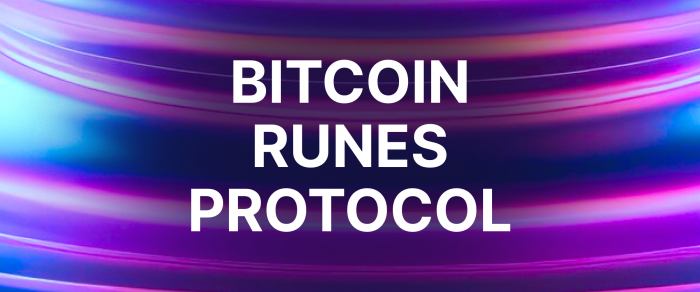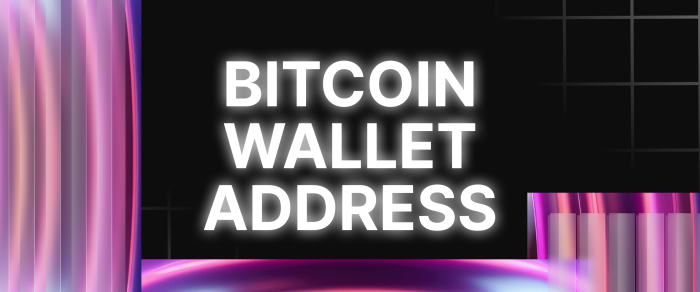What Is Bitcoin Runes Protocol, and How Does it Work?
The digital industry is shaping up quite rapidly, and we get one news item or another almost every day. Now, Bitcoin Runes has surfaced, aiming to improve the creation of tokens. In April, Runes was introduced after the fourth Bitcoin halving. Below, we will explore the concept of Bitcoin Runes, its advantages, possible disadvantages, and general effects.
Key Takeaways:
- A new way to develop tokens is called Bitcoin Runes.
- For effective management, Bitcoin Runes uses its transaction paradigm and unique data storage features.
- Runes make token production easier, use fewer resources, integrate with Bitcoin without problems, and increase miners’ profits.
- Runes create tokens in a different way than BRC-20, which gives them several advantages.
What Are Runes?
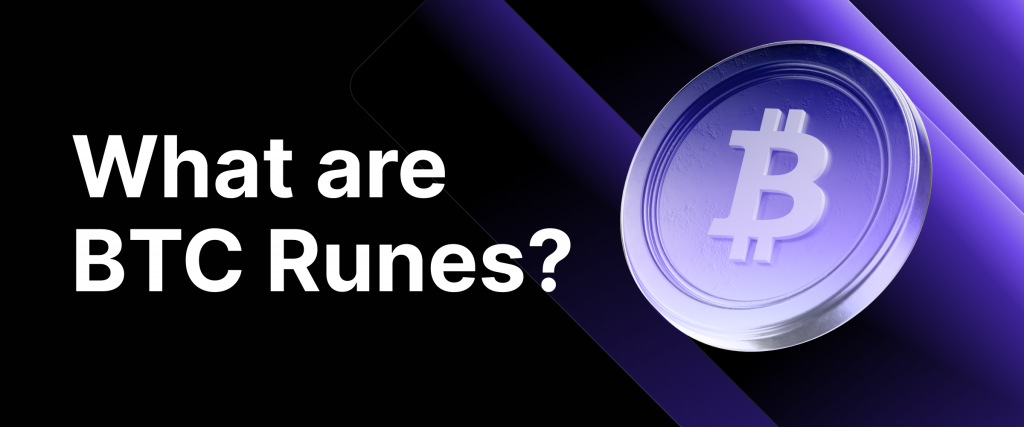
A technology called Bitcoin Runes simplifies the creation and administration of fungible tokens on the Bitcoin blockchain. By using the OP_RETURN opcode and Bitcoin’s UTXO (Unspent Transaction Output) architecture, Runes makes it feasible to create tokens that are easier to use and consume less resources than those made possible by current standards like BRC-20 and SRC-20.
To integrate with the current Bitcoin infrastructure efficiently, the Bitcoin Runes protocol offers a productive way to produce fungible tokens directly within the Bitcoin network.
How Bitcoin Runes Work
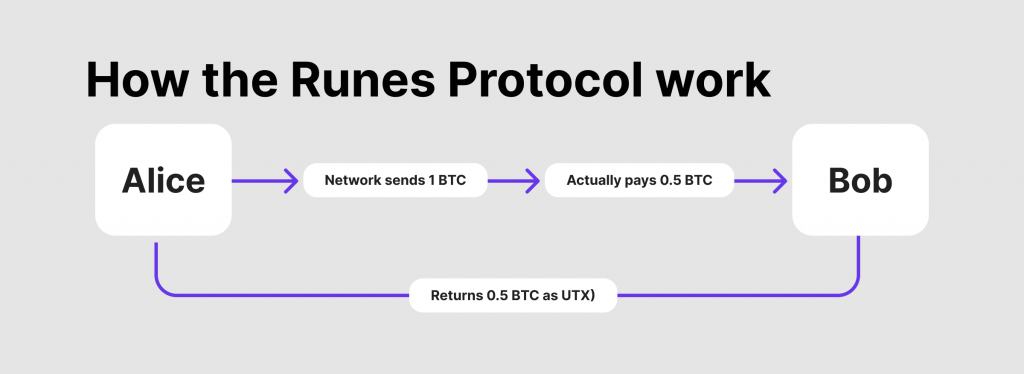
The two fundamental parts of Bitcoin Runes are the UTXO transaction architecture and the OP_RETURN opcode. Every transaction in the UTXO model uses up all of the assets stored in a user’s ledger. Based on the transaction’s instructions, this model generates new UTXOs. This approach minimizes unwanted outputs and guarantees effective token management by clearly outlining the token distribution for every transaction.
Users may include extra data in Bitcoin transactions using the OP_RETURN opcode. It improves token-related data storage without compromising network performance. The OP_RETURN field can integrate essential information like IDs, token names, and transaction commands directly into the transaction using the OP_RETURN field. By storing the data directly on the blockchain, this method guarantees the accessibility and integrity of token data.
These elements work together to allow fungible token creation and administration on the Bitcoin blockchain. The OP_RETURN opcode offers a simple way to integrate required token information into transactions, while the UTXO mechanism guarantees equitable and effective asset allocation. This combination makes it possible for Bitcoin Runes to operate efficiently inside the current Bitcoin infrastructure, making the production and management of tokens easier.
Key Benefits of Bitcoin Runes
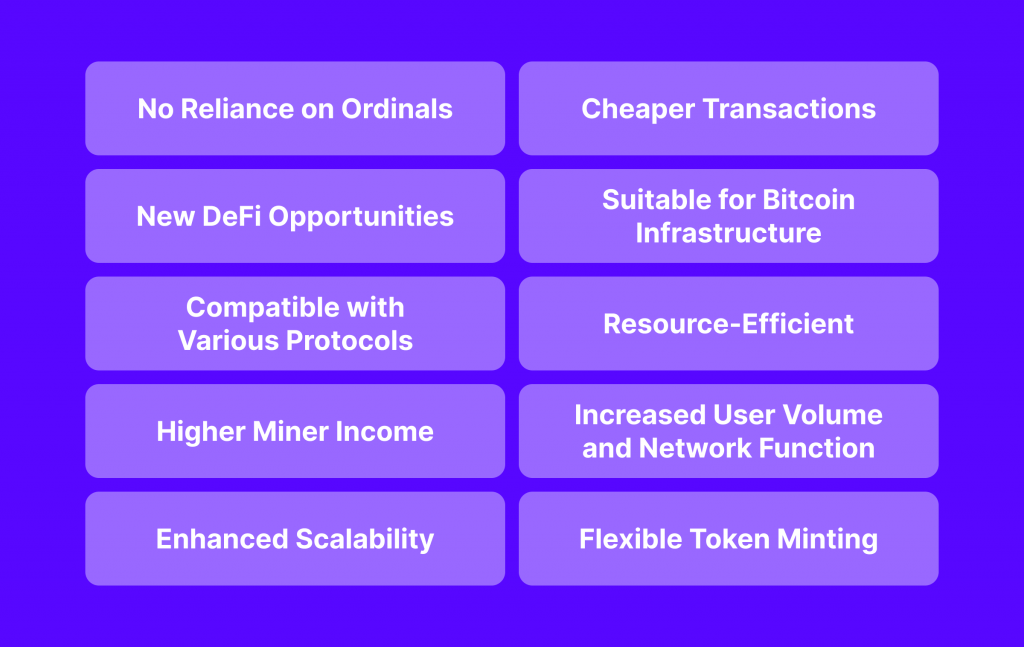
Let’s now break down some crucial elements that characterize the concept of Runes.
Not Relying on Ordinals
Runes are intended to reduce the on-chain footprint and manage UTXOs more efficiently than BRC-20 tokens, which are based on the Bitcoin Ordinals protocol theory and may lead to UTXO proliferation. This strategy lowers blockchain bloat and improves the Bitcoin network’s overall performance.
Diminished Transaction Charges
Unlike other token standards, Bitcoin Runes can result in cheaper transaction costs by optimizing the utilization of UTXOs and minimizing on-chain data storage. Its efficiency makes it a desirable choice for users wishing to produce and administer fungible tokens on the Bitcoin network.
Possibility of Decentralised Finance
The introduction of Bitcoin Runes has created new opportunities for DeFi applications. By facilitating the production of fungible tokens, they can enable direct lending, borrowing, and trading on Bitcoin, among other DeFi activities.
Suitability for the Bitcoin Infrastructure
Runes are easily integrated with the Lightning Network and other components of the current Bitcoin infrastructure. This interoperability increases the usefulness and allure of Bitcoin Runes for both developers and users by enabling quicker and less expensive transactions. Because of its interaction with the Lightning Network, Runes is a viable option for various applications due to its rapid and inexpensive transfers.
Compatibility with Different Protocols
The Bitcoin Runes work with other token standards and protocols, allowing easy integration and communication with various blockchain networks and applications. This compatibility improves the adaptability and usefulness of tokens with the Runes protocol.
Efficiency of Resources
Runes are more resource-efficient than BRC-20, which might cause network congestion due to the overabundance of UTXOs. Runes’ OP_RETURN methodology minimizes blockchain bloat and uses fewer resources. The performance and scalability of the Bitcoin network depend heavily on this efficiency.
A Rise in Miner Income
Runes offer an extra revenue stream in light of the recent halving of Bitcoin’s miner revenue. Rune creation and transfer raise transaction fees, which helps miners and might motivate more people to participate in network upkeep. The stability and security of the Bitcoin network depend on this extra source of revenue.
Increased User Volume and Network Functionality
By facilitating the creation of meme coins and other community-driven projects on the Bitcoin network, Runes hopes to draw on a broader audience. This growth in use cases could create a more dynamic and varied Bitcoin environment, raising network activity and acceptance overall. Runes augment the Bitcoin blockchain’s adaptability and allure by enabling the generation of diverse tokens.
The Ability to Scale
The Runes protocol’s architecture ensures it can grow with the Bitcoin network. Runes leverages the UTXO concept to minimize data storage requirements and handle large volumes of token transactions without affecting the Bitcoin blockchain’s performance. The ability to scale is essential to meet the increasing demand for tokenized assets.
Flexibility in Creating Tokens
The minting process of new Runes tokens is easy and can be incorporated into the Bitcoin Runes protocol. This feature increases the Bitcoin blockchain’s applicability for various uses by facilitating the quick creation of new tokens. Within the Bitcoin ecosystem, the simplicity of token generation encourages experimentation and innovation.
Potential Drawbacks
Bitcoin Runes have many advantages, but a few critical drawbacks should be taken into account. Comprehending these possible problems is essential to evaluating the Runes protocol’s overall effect on the network.

The Speculative Nature
Like meme currencies and other tokens, Bitcoin Runes might promote speculative activity. The Bitcoin network may not benefit or be helpful in the long run from this speculation.
A Rise in Transaction Fees
Bitcoin transaction fees have noticeably increased since the launch of Bitcoin Runes. Although this helps miners, increased prices may prevent normal users from using the network as affordably.
Symbol Squatting
The Runes protocol permits people to claim desired token symbols even in the absence of immediate use. This may result in conflicts and inefficiencies in the token minting runes process.
Fast Fact:
Every Bitcoin Rune is assigned a unique Rune ID, making it simple to identify and trace them across the blockchain.
Runes vs. BRC-20
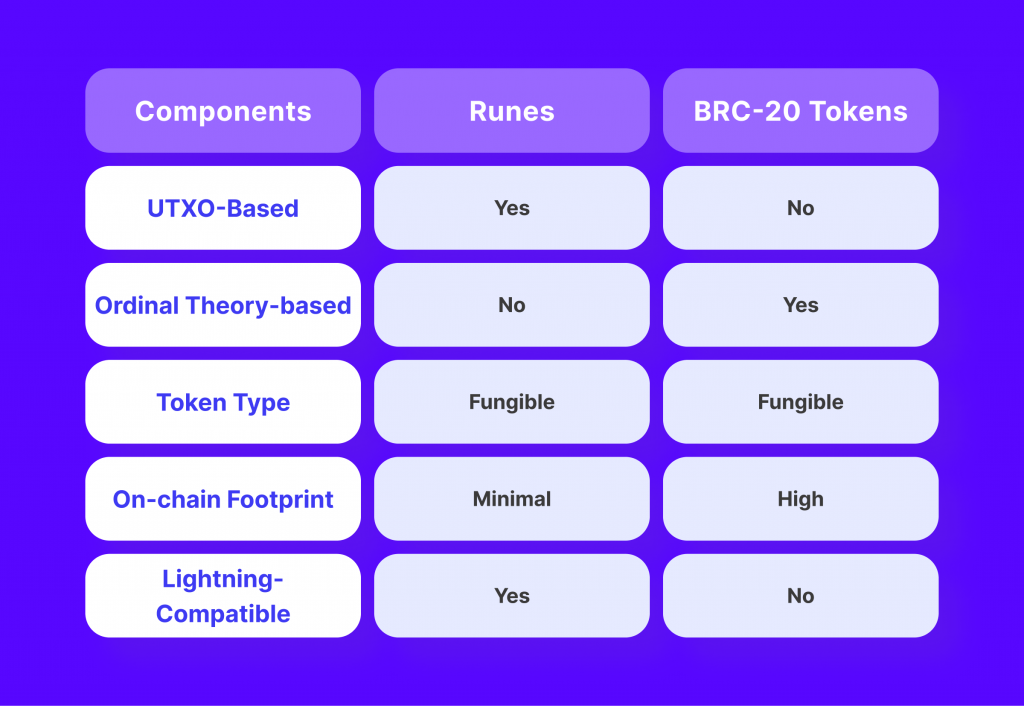
Two methods for creating and managing tokens on the Bitcoin blockchain are Bitcoin Runes and the BRC-20 token standard. Each has its own unique characteristics and design principles. Casey Rodarmor developed Bitcoin Runes, a new approach to creating fungible tokens that are supposed to be more manageable and effective than current standards like BRC-20.
The fundamental style of operation that separates BRC-20 and Bitcoin Runes is a significant distinction. The foundation of Runes is the Unspent Transaction Output (UTXO) model, in which every transaction uses up every asset in a user’s ledger and generates new UTXOs according to its instructions. However, BRC-20 coins depend on the Ordinals protocol, which manages and creates tokens separately.
How data is kept is another crucial difference. Bitcoin Runes stores token-related data, including the token’s name, ID, and commands for particular activities, in the OP_RETURN field of Bitcoin transactions. On the other hand, BRC-20 tokens engrave information straight onto a satoshi, potentially resulting in less effective data administration and storage.
In addition, BRC-20 and Bitcoin Runes have different token minting and transfer processes. Runes provide more flexibility in token production by supporting both open and closed minting processes. They also improve efficiency by enabling several activities across various tokens in a single transaction. On the other hand, BRC-20 tokens can be less effective in managing tokens because of their open minting limitation and the need for fresh inscriptions for transfers.
All things considered, Bitcoin Runes and BRC-20 aim to create tokens on the Bitcoin blockchain, but they differ significantly in functionality and methods. For developers and consumers interested in exploring tokenization on the Bitcoin network, Bitcoin Runes presents an intriguing alternative as they seek to streamline the production and management of tokens while optimizing efficiency.
Final Thoughts
To sum up, Bitcoin Runes is an innovative development in the tokenization process. Their architecture has benefits, including ease of use, economical use of resources, and interoperability with the current Bitcoin network. However, it also has drawbacks, such as the possibility of speculative activity and higher transaction costs.
It will be crucial to monitor how the Bitcoin Runes ecosystem develops in relation to the larger Bitcoin network and the market in general. Their accomplishments may lead to more effective and user-friendly tokenization solutions, encouraging the expansion and improvement of the community as a whole.
FAQs:
How is the Runes protocol implemented?
Runes improves direct token operations. UTXOs are the foundation of this protocol. They allow for more transaction control and are compatible with the original Bitcoin layout.
Where should I keep Rune?
Cold wallets, also known as hardware wallets, offer the safest way to store cryptocurrency offline and for backup purposes.
Is it wise to Invest in Rune?
A multitude of factors need to be taken into account, such as your investment objectives. RUNE might be a suitable choice for you if you’re seeking a cryptocurrency with a distinct use case and lots of growth potential.
